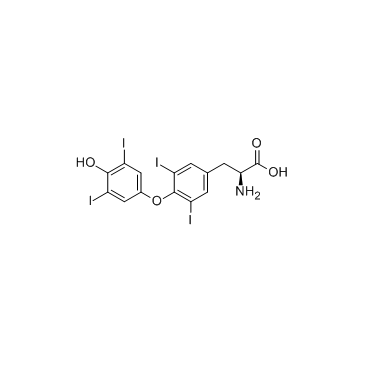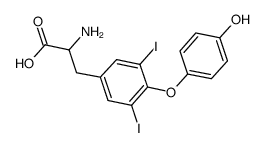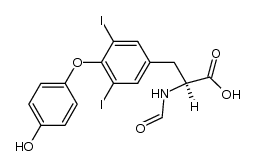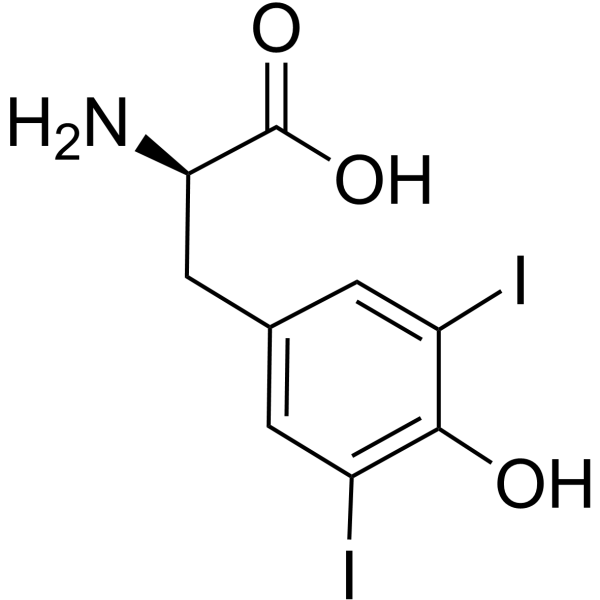51-49-0
| 中文名 | D-甲状腺素 |
|---|---|
| 英文名 | D-thyroxine |
| 中文别名 |
O-(4-羟基-3,5-二碘苯基)-3,5-二碘-D-酪氨酸
右旋甲状腺素 |
| 英文别名 |
EINECS 200-102-7
(2R)-2-amino-3-[4-(4-hydroxy-3,5-diiodophenoxy)-3,5-diiodophenyl]propanoic acid (R)-2-Amino-3-(4-(4-hydroxy-3,5-diiodophenoxy)-3,5-diiodophenyl)propanoic acid D-Thyroxine MFCD00063056 Choloxin Thyroxine 3,3′,5,5″-Tetraiodo-D-thyronine O-(4-Hydroxy-3,5-diiodophenyl)-3,5-diiodo-D-tyrosine |
| 描述 | D-甲状腺素(D-T4)是一种可以抑制TSH分泌的甲状腺激素。D-甲状腺素可用于研究高胆固醇血症[1][2]。 |
|---|---|
| 相关类别 | |
| 参考文献 |
| 密度 | 2.6±0.1 g/cm3 |
|---|---|
| 沸点 | 576.3±50.0 °C at 760 mmHg |
| 熔点 | 225ºC |
| 分子式 | C15H11I4NO4 |
| 分子量 | 776.870 |
| 闪点 | 302.3±30.1 °C |
| 精确质量 | 776.686646 |
| PSA | 92.78000 |
| LogP | 5.93 |
| 外观性状 | 奶油色固体 |
| 蒸汽压 | 0.0±1.7 mmHg at 25°C |
| 折射率 | 1.795 |
| 储存条件 | 应充氩气密封于阴凉干燥处避光保存 |
| 稳定性 | 对光敏感。在237℃时分解。D-甲状腺素生理活性很低。 |
| 分子结构 | 1、 摩尔折射率:125.44 2、 摩尔体积(cm3/mol):294.7 3、 等张比容(90.2K):880.4 4、 表面张力(dyne/cm):79.6 5、 极化率(10-24cm3):49.73 |
| 计算化学 | 1.疏水参数计算参考值(XlogP):2.4 2.氢键供体数量:3 3.氢键受体数量:5 4.可旋转化学键数量:5 5.互变异构体数量:2 6.拓扑分子极性表面积92.8 7.重原子数量:24 8.表面电荷:0 9.复杂度:420 10.同位素原子数量:0 11.确定原子立构中心数量:1 12.不确定原子立构中心数量:0 13.确定化学键立构中心数量:0 14.不确定化学键立构中心数量:0 15.共价键单元数量:1 |
| 更多 | 1. 性状:结晶。 2. 密度(g/mL,25/4℃): 未确定 3. 相对蒸汽密度(g/mL,空气=1):未确定 4. 熔点(ºC): 未确定 5. 沸点(ºC,常压):未确定 6. 沸点(ºC,5.2kPa):未确定 7. 折射率:未确定 8. 闪点(ºC):未确定 9. 比旋光度(º):[α]54621 +2.97°(0.74g溶于6g 0.5mol/L氢氧化钠+14g乙醇) 10. 自燃点或引燃温度(ºC):未确定 11. 蒸气压(kPa,25ºC):未确定 12. 饱和蒸气压(kPa,60ºC):未确定 13. 燃烧热(KJ/mol):未确定 14. 临界温度(ºC):未确定 15. 临界压力(KPa):未确定 16. 油水(辛醇/水)分配系数的对数值:未确定 17. 爆炸上限(%,V/V):未确定 18. 爆炸下限(%,V/V):未确定 19. 溶解性: 未确定 |
Synonym:None Known Section 2 - COMPOSITION, INFORMATION ON INGREDIENTS
Risk Phrases: 20/21/22 Section 3 - HAZARDS IDENTIFICATION EMERGENCY OVERVIEW
Harmful by inhalation, in contact with skin and if swallowed.Light sensitive.The toxicological properties of this material have not been fully investigated. Potential Health Effects Eye: May cause eye irritation. Skin: May cause skin irritation. Ingestion: May cause irritation of the digestive tract. The toxicological properties of this substance have not been fully investigated. Inhalation: May cause respiratory tract irritation. The toxicological properties of this substance have not been fully investigated. Chronic: No information found. Section 4 - FIRST AID MEASURES Eyes: Immediately flush eyes with plenty of water for at least 15 minutes, occasionally lifting the upper and lower eyelids. Get medical aid. Skin: Get medical aid. Flush skin with plenty of water for at least 15 minutes while removing contaminated clothing and shoes. Wash clothing before reuse. Ingestion: Never give anything by mouth to an unconscious person. Get medical aid. Do NOT induce vomiting. If conscious and alert, rinse mouth and drink 2-4 cupfuls of milk or water. Inhalation: Remove from exposure and move to fresh air immediately. If not breathing, give artificial respiration. If breathing is difficult, give oxygen. Get medical aid. Notes to Physician: Section 5 - FIRE FIGHTING MEASURES General Information: As in any fire, wear a self-contained breathing apparatus in pressure-demand, MSHA/NIOSH (approved or equivalent), and full protective gear. During a fire, irritating and highly toxic gases may be generated by thermal decomposition or combustion. Runoff from fire control or dilution water may cause pollution. Extinguishing Media: In case of fire, use water, dry chemical, chemical foam, or alcohol-resistant foam. Use agent most appropriate to extinguish fire. Section 6 - ACCIDENTAL RELEASE MEASURES General Information: Use proper personal protective equipment as indicated in Section 8. Spills/Leaks: Vacuum or sweep up material and place into a suitable disposal container. Clean up spills immediately, observing precautions in the Protective Equipment section. Avoid generating dusty conditions. Provide ventilation. Section 7 - HANDLING and STORAGE Handling: Wash thoroughly after handling. Remove contaminated clothing and wash before reuse. Use with adequate ventilation. Minimize dust generation and accumulation. Avoid contact with eyes, skin, and clothing. Keep container tightly closed. Avoid ingestion and inhalation. Store protected from light. Storage: Keep container closed when not in use. Store in a tightly closed container. Store in a cool, dry, well-ventilated area away from incompatible substances. Hormones and antibiotics room. Store protected from light. Section 8 - EXPOSURE CONTROLS, PERSONAL PROTECTION Engineering Controls: Facilities storing or utilizing this material should be equipped with an eyewash facility and a safety shower. Use adequate ventilation to keep airborne concentrations low. Exposure Limits CAS# 51-49-0: Personal Protective Equipment Eyes: Wear appropriate protective eyeglasses or chemical safety goggles as described by OSHA's eye and face protection regulations in 29 CFR 1910.133 or European Standard EN166. Skin: Wear appropriate protective gloves and clothing to prevent skin exposure. Clothing: Wear appropriate protective clothing to prevent skin exposure. Respirators: Follow the OSHA respirator regulations found in 29 CFR 1910.134 or European Standard EN 149. Use a NIOSH/MSHA or European Standard EN 149 approved respirator if exposure limits are exceeded or if irritation or other symptoms are experienced. Section 9 - PHYSICAL AND CHEMICAL PROPERTIES Physical State: Solid Color: cream Odor: None reported. pH: Not available. Vapor Pressure: Not available. Viscosity: Not available. Boiling Point: Not available. Freezing/Melting Point: 225 deg C Autoignition Temperature: Not applicable. Flash Point: Not applicable. Explosion Limits, lower: Not available. Explosion Limits, upper: Not available. Decomposition Temperature: Solubility in water: insoluble Specific Gravity/Density: Molecular Formula: C15H11I4NO4 Molecular Weight: 776.86 Section 10 - STABILITY AND REACTIVITY Chemical Stability: Stable under normal temperatures and pressures. Conditions to Avoid: Incompatible materials, light, dust generation, excess heat, strong oxidants. Incompatibilities with Other Materials: Oxidizing agents, strong bases. Hazardous Decomposition Products: Nitrogen oxides, carbon monoxide, irritating and toxic fumes and gases, carbon dioxide, nitrogen, hydrogen iodide. Hazardous Polymerization: Has not been reported. Section 11 - TOXICOLOGICAL INFORMATION RTECS#: CAS# 51-49-0 unlisted. LD50/LC50: Not available. Carcinogenicity: D-Thyroxine - Not listed by ACGIH, IARC, or NTP. Section 12 - ECOLOGICAL INFORMATION Section 13 - DISPOSAL CONSIDERATIONS Dispose of in a manner consistent with federal, state, and local regulations. Section 14 - TRANSPORT INFORMATION IATA Not regulated as a hazardous material. IMO Not regulated as a hazardous material. RID/ADR Not regulated as a hazardous material. Section 15 - REGULATORY INFORMATION European/International Regulations European Labeling in Accordance with EC Directives Hazard Symbols: XN Risk Phrases: R 20/21/22 Harmful by inhalation, in contact with skin and if swallowed. Safety Phrases: S 24/25 Avoid contact with skin and eyes. S 28A After contact with skin, wash immediately with plenty of water. S 37 Wear suitable gloves. S 45 In case of accident or if you feel unwell, seek medical advice immediately (show the label where possible). WGK (Water Danger/Protection) CAS# 51-49-0: No information available. Canada None of the chemicals in this product are listed on the DSL/NDSL list. CAS# 51-49-0 is not listed on Canada's Ingredient Disclosure List. US FEDERAL TSCA CAS# 51-49-0 is not listed on the TSCA inventory. It is for research and development use only. SECTION 16 - ADDITIONAL INFORMATION N/A |
| 危害码 (欧洲) | Xn:Harmful; |
|---|---|
| 风险声明 (欧洲) | R20/21/22 |
| 安全声明 (欧洲) | S24/25 |
| WGK德国 | 3 |
| 海关编码 | 2922509090 |
|
~% 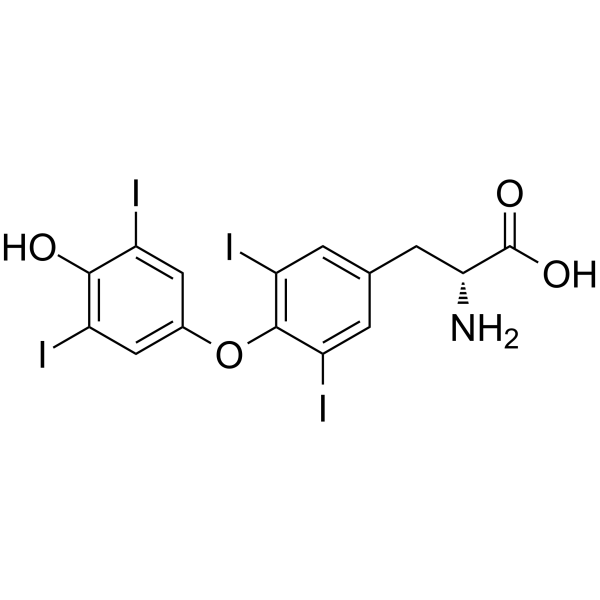
51-49-0 |
| 文献:BOARD OF REGENTS, THE UNIVERSITY OF TEXAS SYSTEM; ARMSTRONG, Daniel, W.; PING, Sun; BREITBACH, Zachary, S.; WANG, Chunlei Patent: WO2010/148191 A2, 2010 ; Location in patent: Page/Page column 45-49; 61 ; |
|
~% 
51-49-0 |
| 文献:Harington Biochemical Journal, 1928 , vol. 22, p. 1433 |
|
~% 
51-49-0 |
| 文献:Harington Biochemical Journal, 1928 , vol. 22, p. 1433 |
|
~% 
51-49-0 |
| 文献:Harington Biochemical Journal, 1928 , vol. 22, p. 1433 |
|
~% 
51-49-0 |
| 文献:Harington Biochemical Journal, 1928 , vol. 22, p. 1433 |
|
~% 
51-49-0 |
| 文献:Pitt Rivers; Lerman J. Endocrin., 1946 , vol. 5, p. 223,225 |
|
~% 
51-49-0 |
| 文献:Elks; Waller Journal of the Chemical Society, 1952 , p. 2366,2369 |
|
~% 
51-49-0 |
| 文献:Elks; Waller Journal of the Chemical Society, 1952 , p. 2366,2369 |
|
~% 
51-49-0 |
| 文献:Pitt Rivers; Lerman J. Endocrin., 1946 , vol. 5, p. 223,225 |
| 上游产品 7 | |
|---|---|
| 下游产品 0 | |
| 海关编码 | 2922509090 |
|---|---|
| 中文概述 | 2922509090. 其他氨基醇酚、氨基酸酚及其他含氧基氨基化合物. 增值税率:17.0%. 退税率:13.0%. 监管条件:AB. 最惠国关税:6.5%. 普通关税:30.0% |
| 申报要素 | 品名, 成分含量, 用途, 乙醇胺及其盐应报明色度, 乙醇胺及其盐应报明包装 |
| 监管条件 | A.入境货物通关单 B.出境货物通关单 |
| 检验检疫 | R.进口食品卫生监督检验 S.出口食品卫生监督检验 |
| Summary | 2922509090. other amino-alcohol-phenols, amino-acid-phenols and other amino-compounds with oxygen function. VAT:17.0%. Tax rebate rate:13.0%. . MFN tariff:6.5%. General tariff:30.0% |



